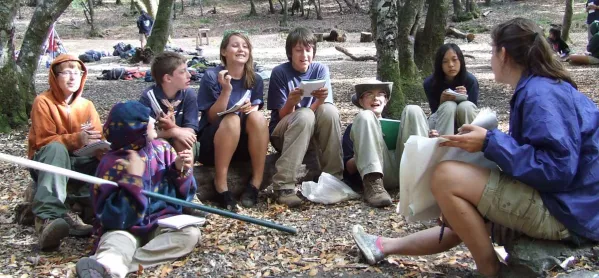- Home
- ‘Outdoor learning: the key to happy, healthy and creative children’
‘Outdoor learning: the key to happy, healthy and creative children’

This piece first appeared on Usable Knowledge, from the Harvard Graduate School of Education.
With the school year in full swing, it can be easy to forget one of the chief joys of the summer: Just being outside. Now, a growing number of researchers and educators are finding that outside time has benefits beyond leisure - and may be the key to happy and healthy children, schools, and communities.
Far-reaching, lasting benefits
Outdoor education encompasses a range of experiences, settings, and pedagogical goals. “Unplugged” sessions at overnight camp, or Outward Bound-type trips with classmates, are often the first images that come to mind.
But outdoor education can be as simple as a lesson taught outside - entirely unrelated to nature, or using the outdoor landscape to teach sustainability or biology. Or it can be simpler still: playing outside, using free time to organize a game or investigate a wild section of the playground.
Each of these interactions has its own benefits, but the overall impact of time spent outdoors is clear: better physical health and wellness; increased environmental stewardship; enhanced creativity, concentration, and self-confidence; and stronger collaboration and relationship skills.
Environmental psychologist Louise Chawla has found that frequent contact with nature can reduce symptoms of attention-deficit disorder and increase memory; it’s also associated with lower rates of depression.
Other studies have shown that time outdoors leads to lower rates of myopia among children, possibly because the high light intensity outside can stimulate retina growth. And more generally, exploring the outdoors introduces children to new sights and sounds and broadens their perspective beyond their immediate families and schools, says Jessica Parsons, who specialized in the topic while earning a master’s degree from the Harvard Graduate School of Education (HGSE).
Ben Wild, another HGSE alum, spent years leading teenagers on backpacking trips, helping kids become both self-sufficient and mutually reliant as they survived in the wilderness for a week. And because the students couldn’t bring any technology or reading material, they had ample time to set goals and reflect on the journey, skills they brought back to the classroom. They learned how to take risks responsibly, in a safe (and fun) context.
Working at a summer camp in Los Altos Hills, California, HGSE LecturerSarah Leibel noticed other advantages. Her campers, who spent several weeks without cell phones, learned to make the most of the free time they had outdoors with their new friends, developing stronger conversational and interpersonal skills. And because they had so much time to run around and move their bodies, it became easier for them to relax and be still when it was time for a break.
But children and teens don’t have to travel far to benefit from the outdoors. In her research at HGSE, alum Erica Fine found that “frequent, close-to-home experiences are one of the best tools we have at connecting kids to nature.”
Students who have a chance at recess to explore a tree or a wild patch of grass learn to be creative within their surroundings. Regular time outside gives kids more opportunities to exercise, and it lets them notice and appreciate all of nature - not just breathtaking views seen while camping, but also ants on the playground or a squirrel in the yard.
Bringing the outdoors to the school day
Compiling the advice of our experts, we offer seven simple suggestions for educators to integrate the outdoors into the school year:
- Designate a “wild” area of the schoolyard for children to explore. Let the grass grow and animals make nests, and keep sticks and branches within reach of students. Encourage students to climb, discover, and play in the area.
- Create an outdoor classroom where groups can meet to read, write, draw, or learn about the environment.
- Let students eat lunch and do phys ed outside, weather permitting.
- Foster partnerships between schools and local parks. Visit parks for outdoor lessons and free play, and offer to let the town use school playgrounds on weekends. These partnerships can be especially important for urban, low-income students, who may have fewer opportunities to visit green spaces on their own.
- Take students for a walk during the day to make observations about the environment, to practice mindfulness, or to complete a teamwork activity.
- Plan a fieldtrip where students can experience nature without technology. While immersive overnight programs can be transformational for students, they can also be expensive. Single-day adventures can be just as fun, with longlasting benefits.
- Model the kind of engagement you want your students to have with nature. Explore new developments on the playground, play with fallen leaves, and vocalize what you notice and love about the outdoors.
Outdoor Classroom Day is October 6, 2016.
Want to keep up with the latest education news and opinion? Follow TES USA on Twitter and like TES USA on Facebook.
Keep reading for just £1 per month
You've reached your limit of free articles this month. Subscribe for £1 per month for three months and get:
- Unlimited access to all Tes magazine content
- Exclusive subscriber-only stories
- Award-winning email newsletters



